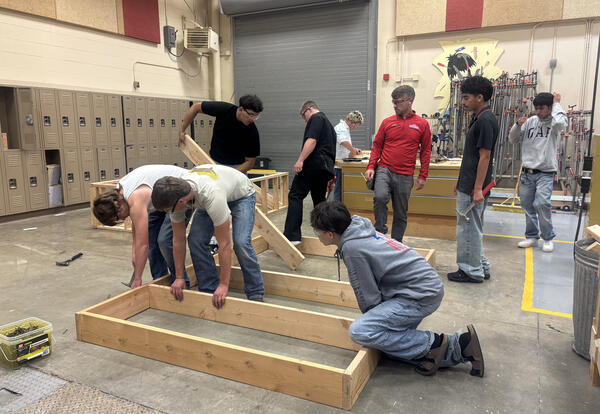
Construction Foundations instructor Eric Duffey helps students apply classroom learning to real-world building projects.
The hum of saws, the thud of hammers, and the shuffle of lumber sliding across the floor: step inside Eric Duffey’s Construction Foundations course at Eastmont High School, and you’ll know right away this isn’t a typical class period. Students wear earplugs, eye protection, and safety gear while operating power tools and machinery. Amid the noise, students are practicing precision and responsibility. These are skills that push them to think critically and solve problems in real time.
Duffey, who previously taught similar courses at Eastmont Junior High and has a drafting background, now teaches in Eastmont’s Career & Technical Education (CTE) program. Within CTE, the Woods Technology & Construction Pathway introduces students to woodworking, design, and construction skills. Courses in this pathway can count as electives or even as a fine arts credit, giving students more flexibility as they plan their high school experience, but it goes far beyond shop basics.
In fact, this year’s Construction Foundations students are building a fully functioning bathroom (including everything from framing to tiling to electrical work), giving them first-hand experience in how different trades come together in real-world projects.
Duffey says the value goes beyond career preparation. “It’s important for students to have a basic understanding of how to take care of their future homes,” he explained. “There are jobs where students can learn how to problem solve, so these skills matter in everyday life too.”
Students don’t just learn about woodworking, they try it for themselves. They measure, cut, and assemble projects that range from simple toolboxes to more advanced builds. Along the way, they learn how different types of wood behave, why safety gear matters, and how to use everything from hand tools to modern machinery. The bigger focus is on collaboration and career-connected learning, building both competence and confidence as students see how their classroom work links directly to real-world skills.
For some, the skills are personal. Senior Graysea Lopez has crafted a toolbox, table, cutting board, and gifts for family members. “I’ve enjoyed wood working,” she said. “My dad was a cabinet maker.”
From building furniture to preparing for restoration or construction careers, these classes give students options. As Duffey explains, the goal is to help them feel comfortable and confident, whether they pursue a skilled trade, a design pathway, or simply want the know-how to solve problems at home.
So, whatever happened to woodshop? At Eastmont, it never left. It’s alive, loud, thriving, and equipping students with real-world skills for today and the future.
Want to get more news like this one? Go directly to the Join Community Groups sign-up page. View all Eastmont News.
